[ZX Spectrum, Omega Games]
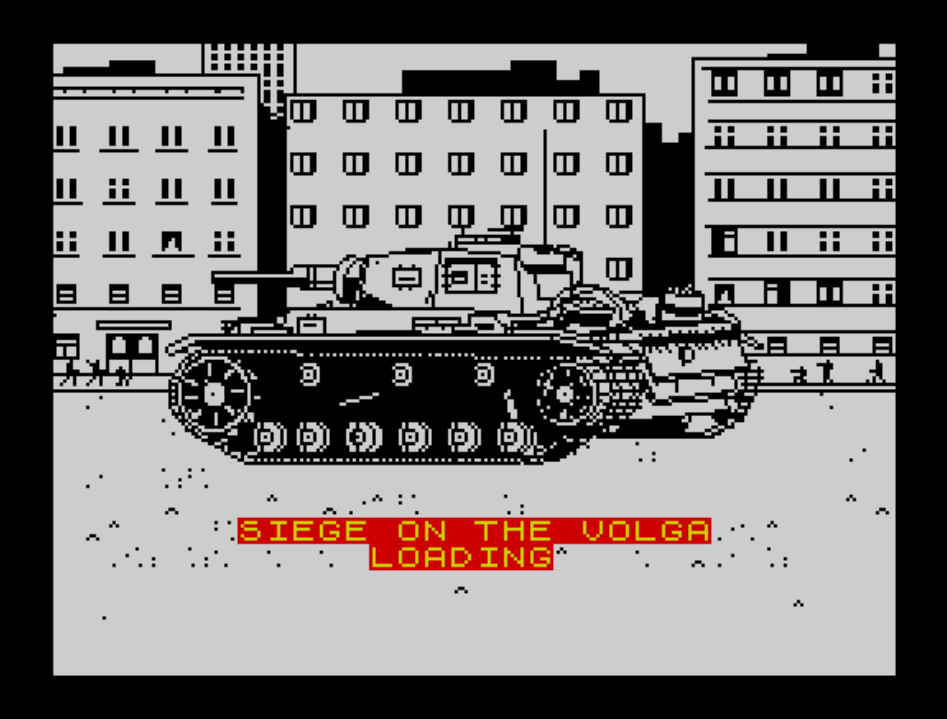
Stalingrad is one of those battles that I don’t need to introduce, and yet it is the first time that I encounter a game specifically about the battle of Stalingrad, and even then it did not come from any of the established publishers on Apple II but by a one-game company called Omega Games on Spectrum. Can they deliver?
Siege on the Volga starts on the 13th of September 1942. The player, representing the German force, has 8 weeks [turns] to take all the districts of Stalingrad. The game was shipped with a good-looking physical map of the city, which was of great convenience, because the in-game map does not include the names of the districts, but still requires you to know them to give your orders.
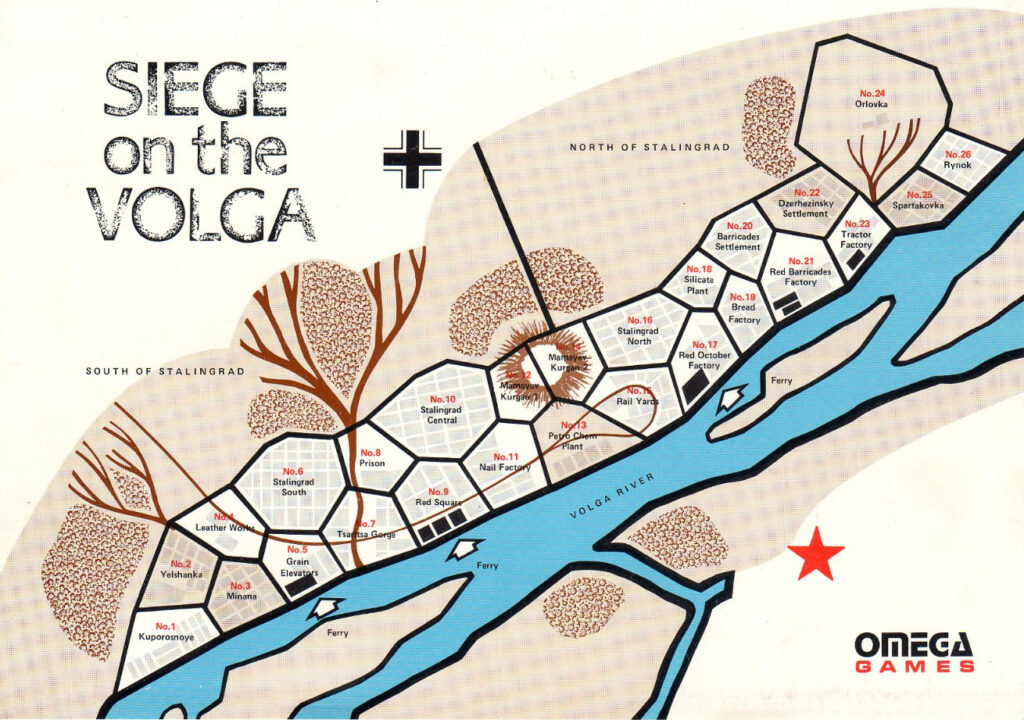

I start the campaign with 8 divisions, which can enter Stalingrad through any of the “external layers” of the City. The various divisions are of various quality, ranging from the 24th Panzer (strength: 65) to the KG Krumpen (strength:32). All divisions have very high morale – this mission should be easy after all.
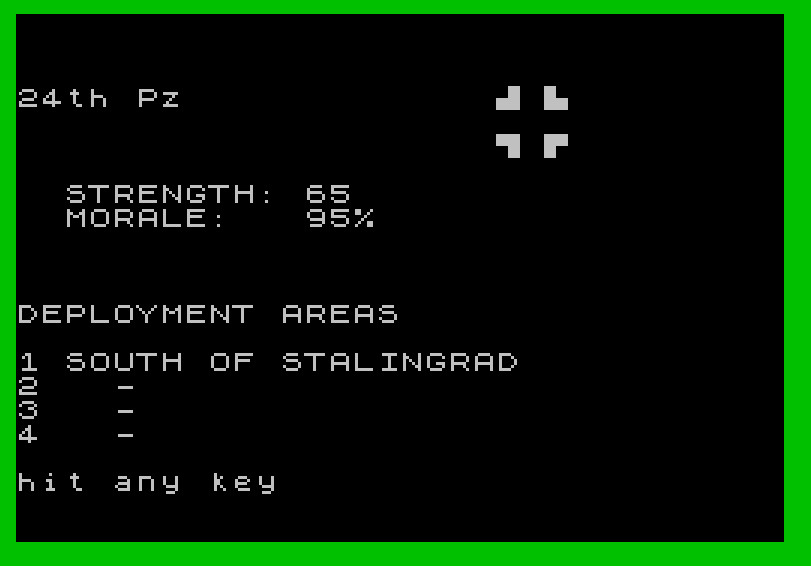
The map shows three reinforcement points for the Soviets: the Grain Elevators district, the Red Square district and the Red October Factory, so they will become my initial objective. My forces will penetrate the city by an assault on Stalingrad South [6], the Prison District [8] and Stalingrad North [16]. The game proposes 4 levels of attacks (Reconnaissance in Force, Sudden, Normal and Maximum Effort), but I don’t know the difference (the manual of the game is lost), so normal it is!
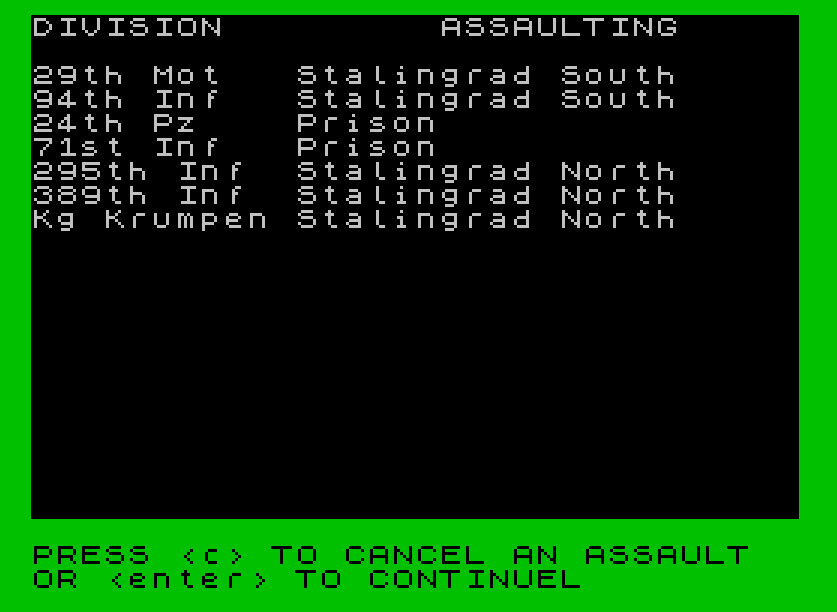
After that, it’s time to assault. Action phases are split in 4 stages, during which both the Germans and the Soviets alternatively execute their assaults.
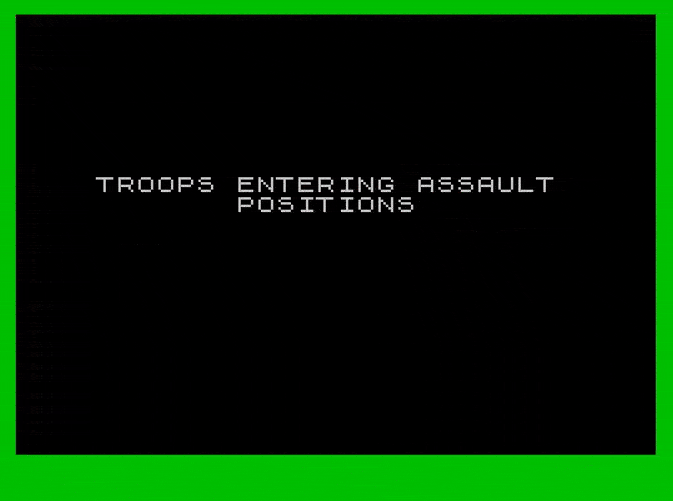
After a district has been cleared of Soviet presence, the game proposes that the units attack another district, which I only accept if said district is one of the disembarkment spots I want to reach. By the end of the assault resolution, I have a foothold on the Grain Elevators district, the Red Square district and the Red October Factory, but have not cleared the Soviet defenders – this will be for the second week.
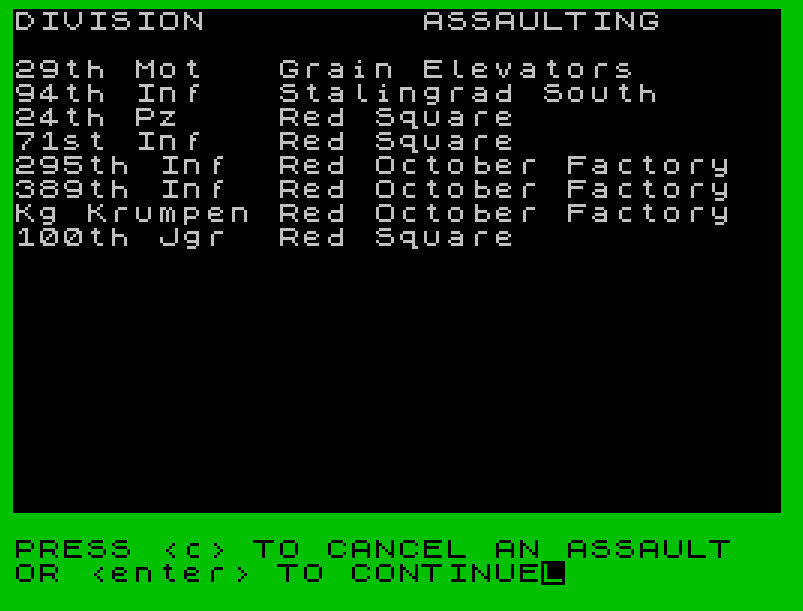
The first landing stage captured is the Grain Elevators district, despite the weakness of my forces there. It allows me to follow up with an attack on the Leather Works district, also captured in the same week.
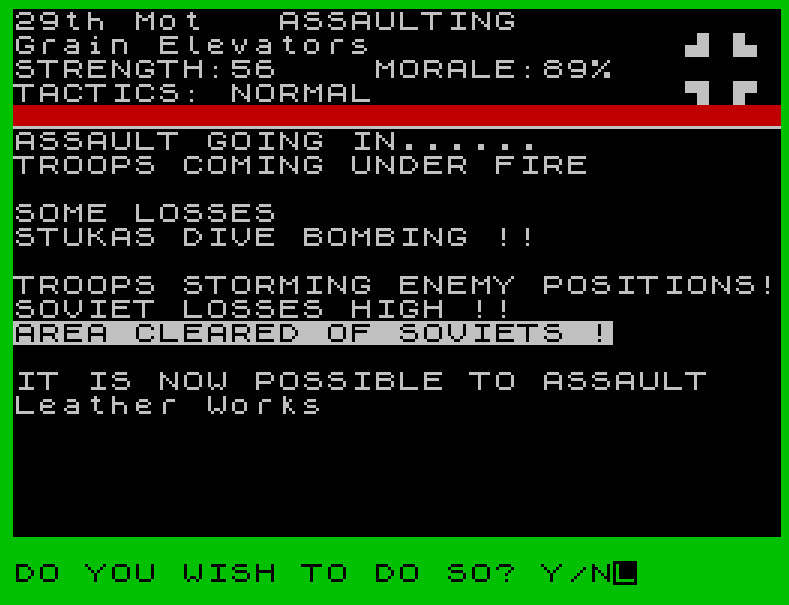
Shortly thereafter, I capture the Red October Factory, despite several Soviet counterattacks.
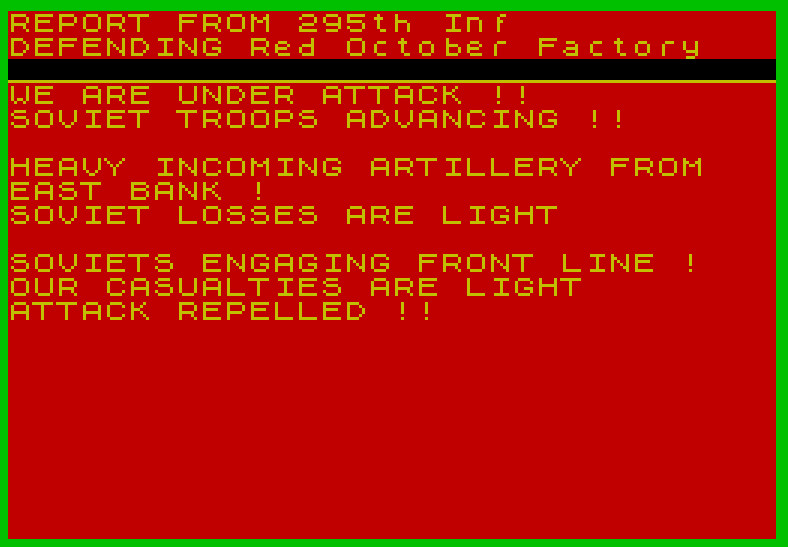
The Red Square district falls last, ending the free flow of reinforcements from the East Bank of the Volga. Nonetheless, the Soviets can still attempt “assault crossing”, and indeed they pull one on the Grain Elevators district. They gain a foothold, but not enough to bring more reinforcements.
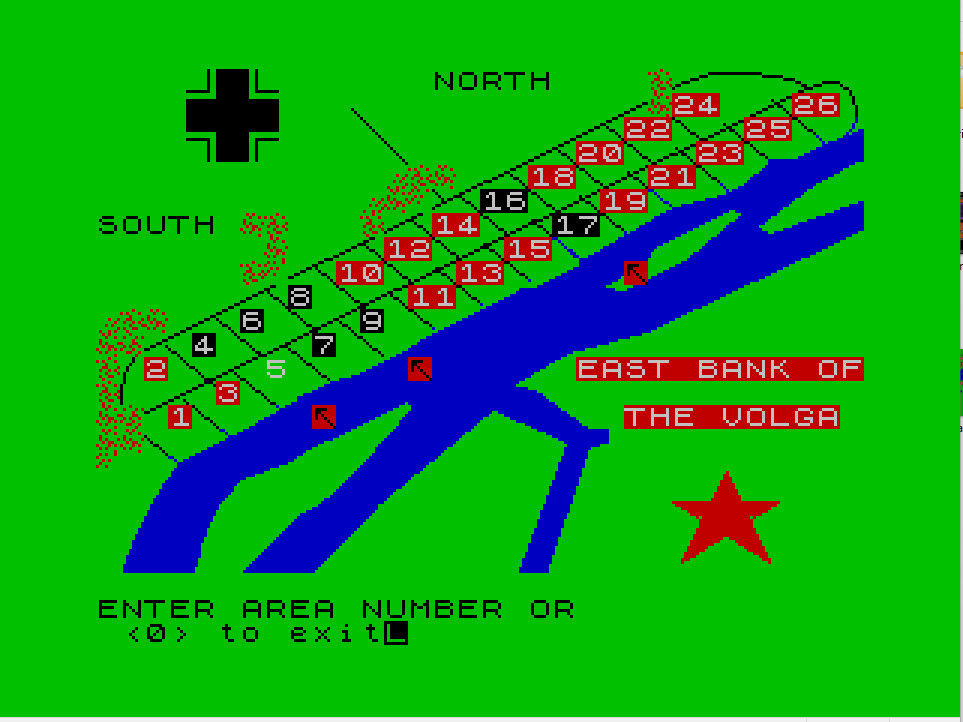
During the following “administration phase”, I lose the 29th Motorized Division, with only a weak (strength = 10) KG Janecke left behind.
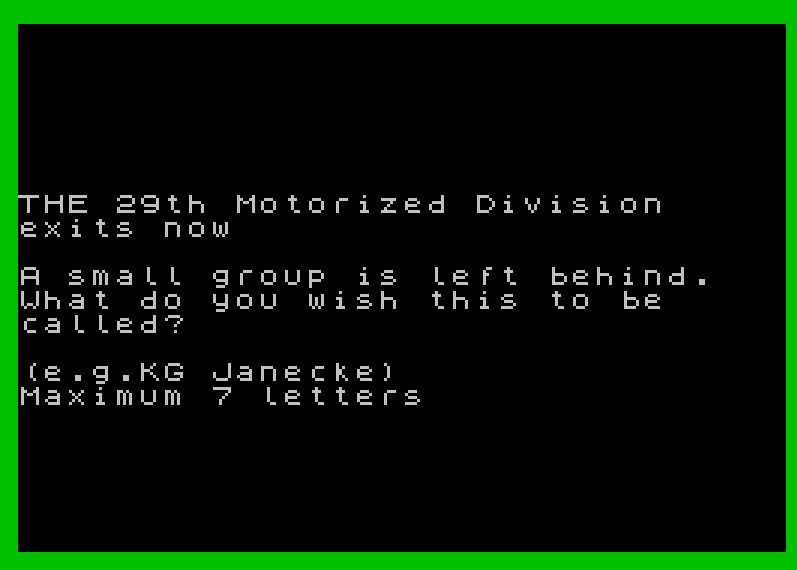
Now is a good time to talk about defence: 9 units would not be enough to defend everything I captured, so in Siege on the Volga, units can occupy up to 4 districts, which they all defend. It is better to occupy fewer than that, because as I understand the game your units need empty slots to attack.
My objective in the following weeks is to expel the Soviets from the Southernmost part of Stalingrad: the Kuporosnoye [1], Yelshanka [2] and Minana [3] districts, in addition of course to the Grain Elevators. For this, I allocate all my forces with high morale, the rest will rest and defend the Red Square. Meanwhile, the units holding the Red October Factory will expand their control toward the South, with of course the project of joining the two “fronts”. The plan turns out to be an almost complete success:
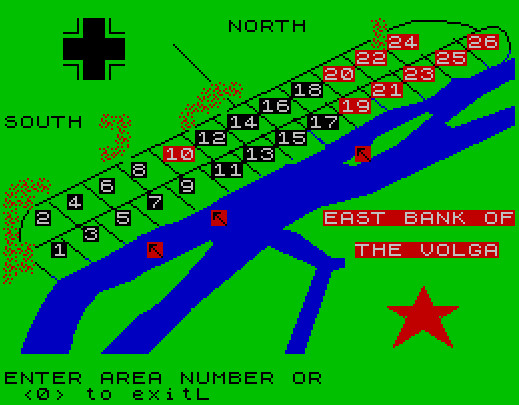
At this point, the game is pretty much won. The Soviets will try to cross the Volga en force, but most of the time their assault ships are destroyed, and when they gain a foothold, it is never sufficient to bring more reinforcements, so I easily push them back to the river the following turn.
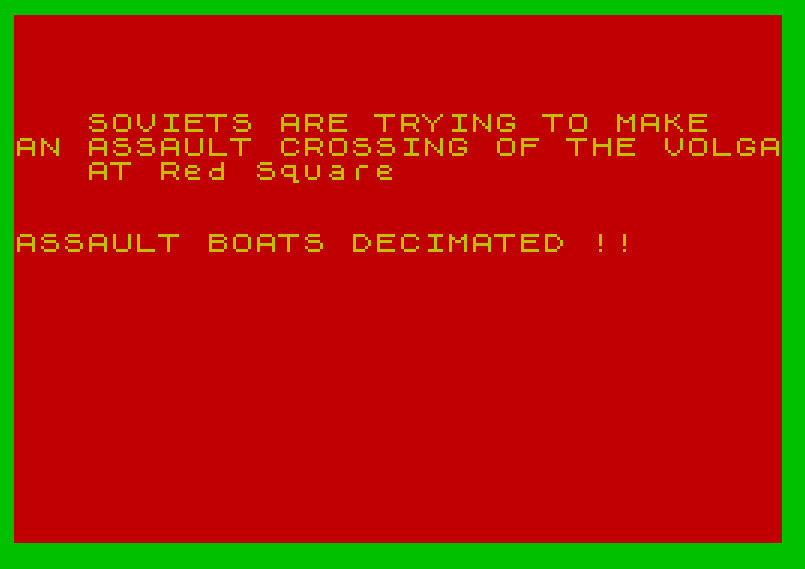
I do have a bit of a surprise the following turn however, when the Soviets manage to liberate most of the centre of Stalingrad that I had left undefended.
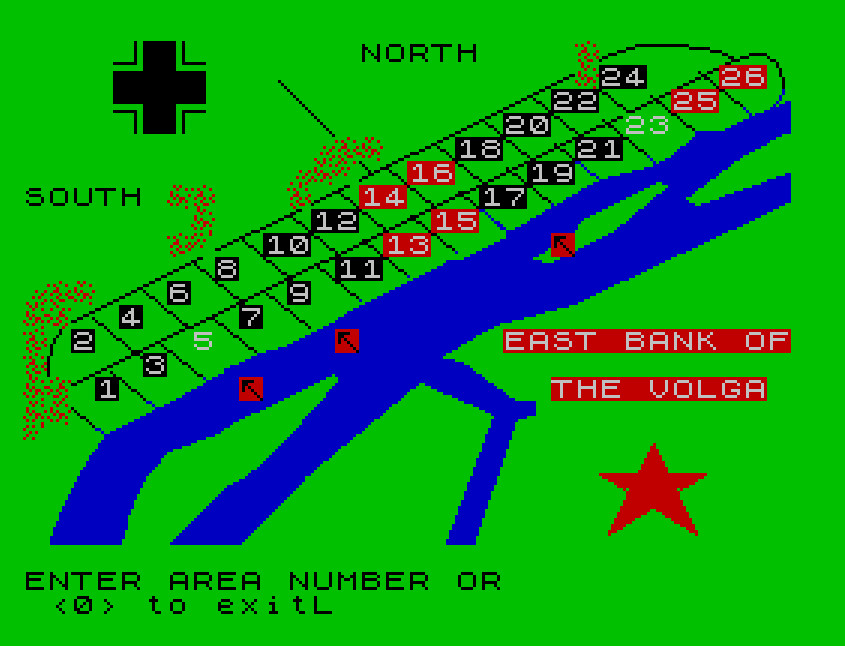
However, the intelligence reports reveal that those central districts are devoid of defenders, so presumably that’s one unit moving through them and now occupying the Rail Yards district [15]
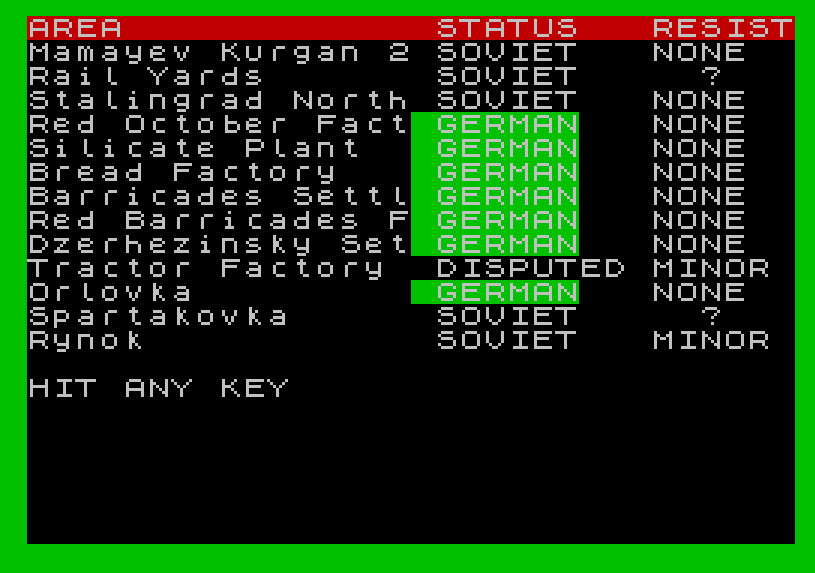
Four units surround the central area and recapture it, three defend the disembarkment spots and four take the remaining two districts on the following turn. The Soviets only survive one more turn because the Red Barricade Factory district resists against all odds – I guess it’s in the name.
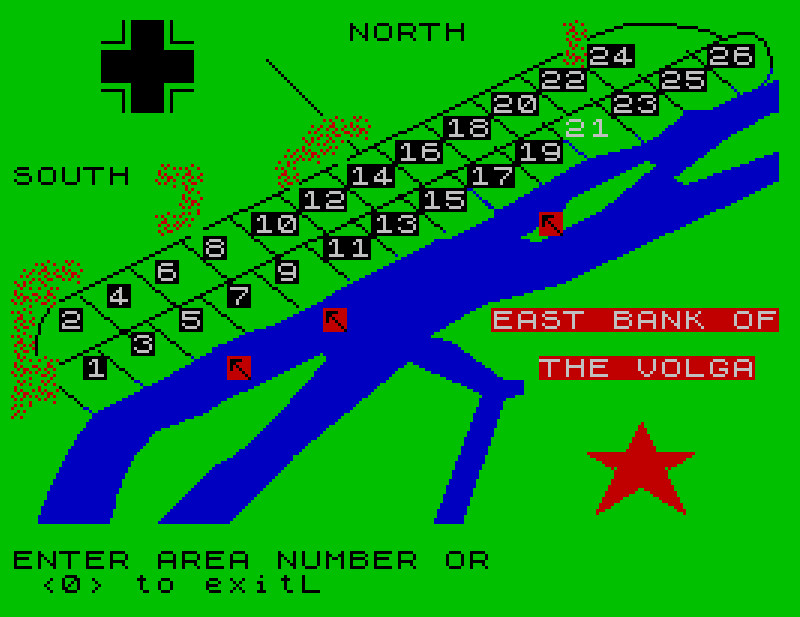
This triggers the second and last “hardcoded event” the game has:

The following turn, the last trace of resistance in Stalingrad is removed, and the game ends.
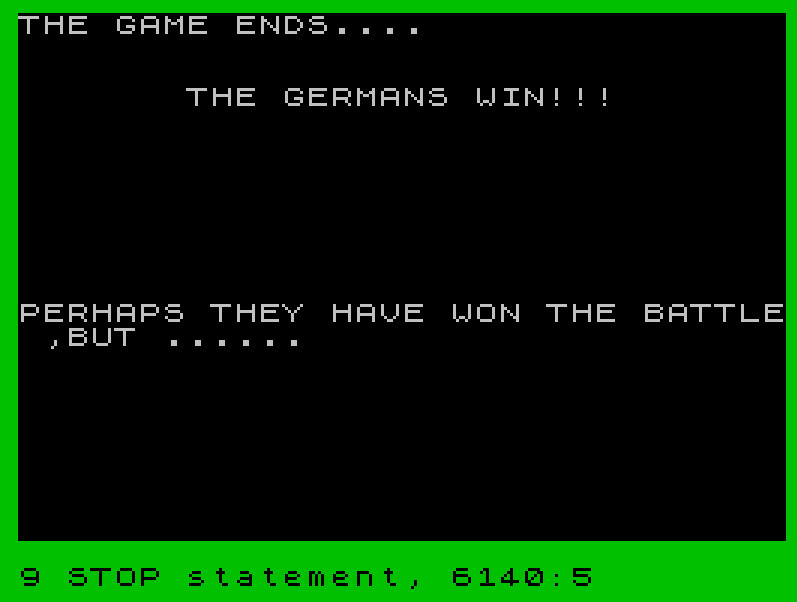
Ratings & Review
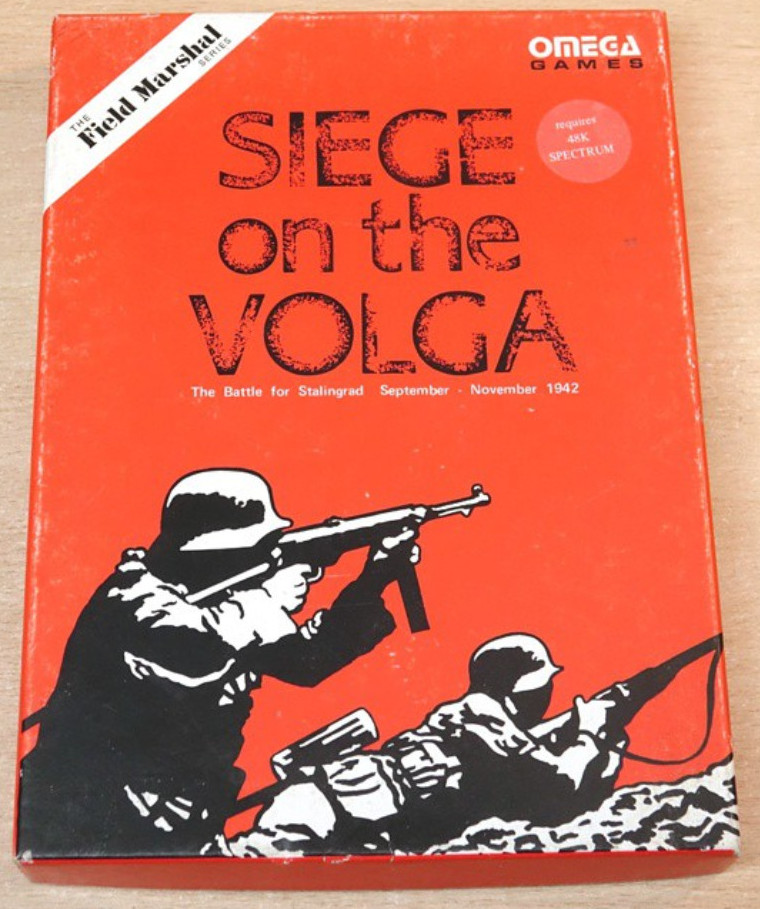
Siege on the Volga by Nig Locke and Richard Shackel, published by Omega Games, UK
First release: December 1984 or earlier on ZX Spectrum
Genre: Land Operations
Average duration of a battle: 1 hour
Total time played: 2 hours
Complexity: Low (1/5)
Final Rating: Obsolete
Context – I am afraid I have very little context on this game: I could not find anything on the authors, I could not find anything on the company, which is a different Omega Games than the American company of the same name, and I could not find any ads for the game. The only reason I date this game “December 1984” is that a video game retailer mentions the game in one of the ads it published in Personal Computer News – that’s all I have on this front.
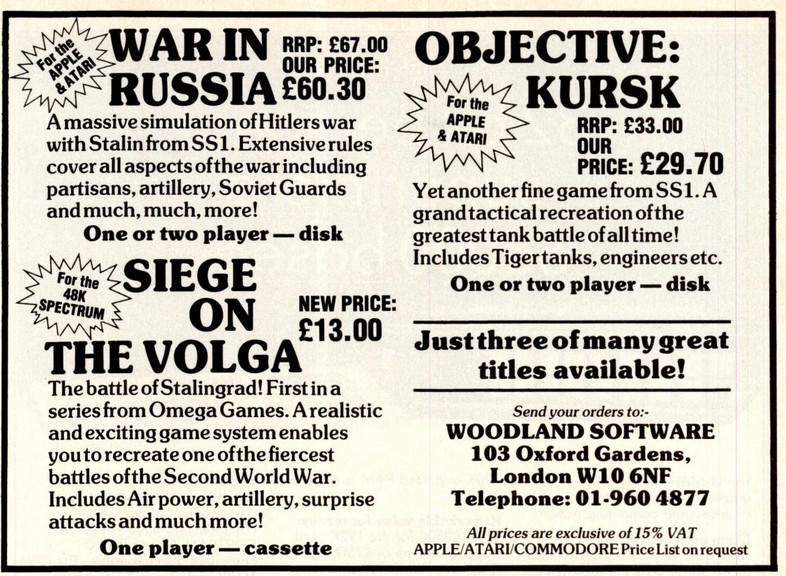
Siege of the Volga was the first, but also the last, of a series called Field Marshal. From pictures I could find, the production value of the game was very high with a map and counters. Alas, that’s all I can say about it, the manual has not been digitalized so if there is more information in it, it is not available.
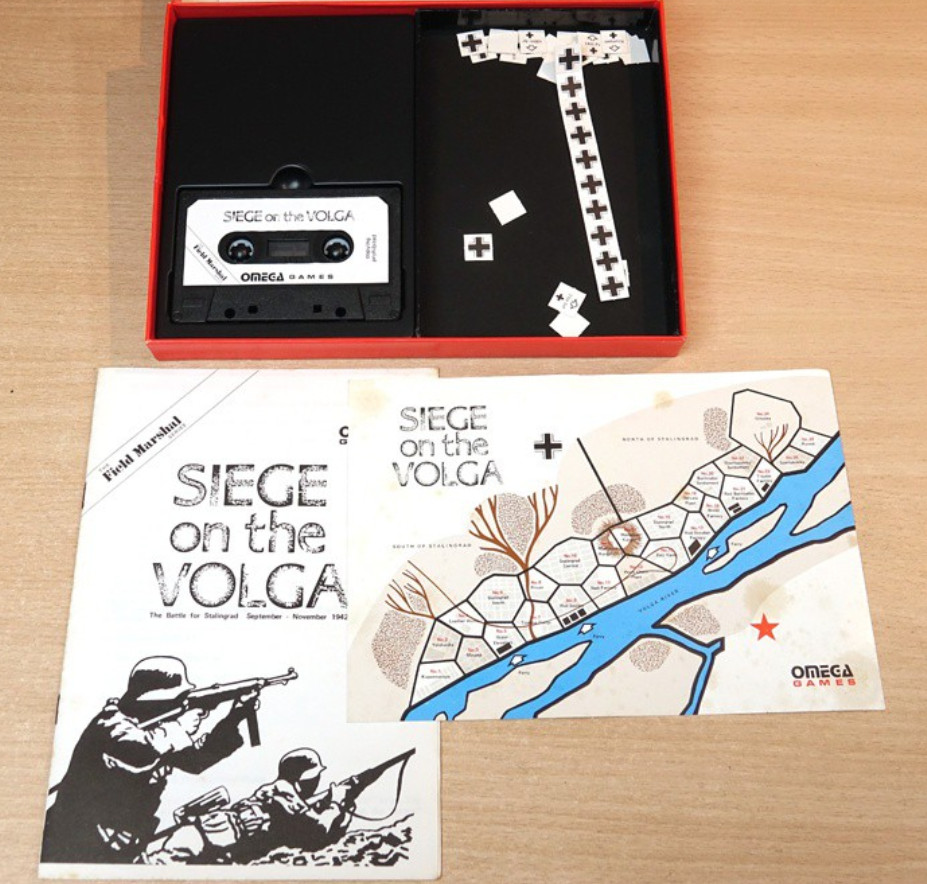
Despite the specific name, I could only find one review for Siege on the Volga in the 31st October 1986 issue of the Portuguese newspaper A Capital. Daniel Lima calls it a “reasonably well-crafted game” and something “strategy lovers should definitely include it in their collection”, though really poor in art.
Edit: Commenter LanHawk then found another by John Minson in Popular Computing Weekly, 18th April 1985. The game receives 3 stars with the following comment: “it’s best suited not to the general computer gamer but the cardboard general could find it a satisfyingly different experience to die rolling.” The review also mentions crashes on wrong inputs that I did not encounter.
Traits – There is a lot of historical detail in Siege on the Volga, but not a lot of depth: units, whether infantry or Panzer, are distinguished only by their starting strength, and the only choice is what to attack – even the various “levels” of attacks from Reconnaissance to Maximum Effort did not seem to make much of a difference; attacking from multiple directions does not seem to have any impact either. In my experience of the game (two attempts: my initial test of the game and this AAR), there aren’t a lot of viable strategies: either you take the disembarkment spots early and then easily win as I did in the AAR, or you don’t take them early enough and lose. In my test game, I ended up allocating 7 units for 3 turns to take the Red Square district, but the Soviet resistance was so massive that almost all battles ended with “no casualties on the Soviet side”.
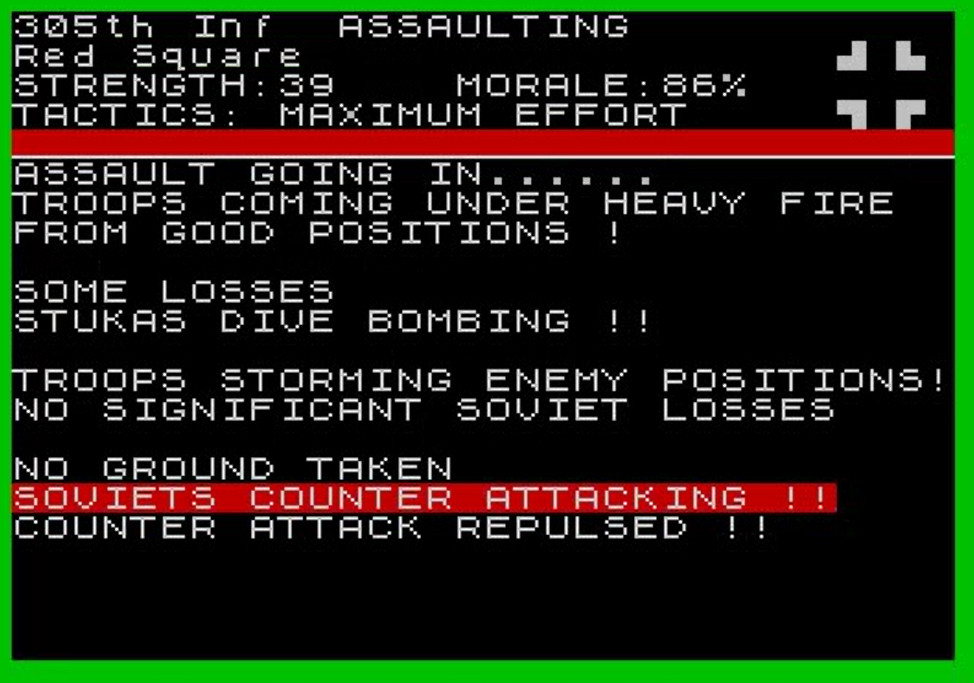
The game could have been more pleasant with a better UI. The game returns to the root menu every time you take a decision, so if you want to disengage a unit from the 3 locations it is, then move it to a new location, then assault, you need to navigate to the orders, and then to the specific unit 5 times – it makes the game longer than it could have been. Nonetheless, I liked the in-game map of Stalingrad and the way combat results are displayed.
Did I make interesting decisions? Rarely, mostly allocation of forces.
Final rating: Obsolete, but it was different enough not to be unpleasant.
Ranking at the time of review: 78/166. I won’t replay it – eck, I wouldn’t have replayed it if I had properly recorded my test game – but that first game was a somewhat OK experience.
8 Comments
It’s definitely starting to seem noticeable how often these Eastern Front games have the player as Nazi Germany rather than the Soviet Union. I wonder why that was?
I surmise you have a hypothesis, and you should state it clearly so it can be discussed :).
No need to wonder! There’s an entire book about the subject (“The Myth of the Eastern Front: The Nazi–Soviet War in American Popular Culture ” by Smelser and Davies). I roughly agreed with their analysis regarding wargaming and the popular view of the Eastern Front. One has to remember that sources and context shape output particularly in the pre-Internet era: with no Soviet historiography translated or their archives inaccessible the main source for the Eastern Front was of course German memoirs and historiography, that sometimes had a vested interest in some partial representation for political or personal reasons. Furthermore, the enemy of yesterday was the ally of today, and contemporary politics do shape even the pop kultur landscape.
Why there are so few of the Pacific games covered by the Scribe that let you fight for the Emperor, much to my chagrin?
The opposite, amusingly was also true: I remember a charming Hungarian wargame of Cold War vintage where the mere option of playing the Germans sent the censors into a frenzy.
Fascinating subject, that should be treated with care and attention.
In Activision’s “Guadalcanal” you can play as the Japanese in the long campaign, but not the short one. Lots of battleships!
> Why there are so few of the Pacific games covered by the Scribe that let you fight for the Emperor
At least there are some. I am still waiting for a game where you can play the Viet Cong, despite their victory against the U.S. being among the most incredible modern-history cases of David beating Goliath.
Hahaha, my knowledge of obscure games is useful again…
Maybe, does it have to be a strategic level game about the whole war? If not then there’s a niche developer called WDS that has a few tactical games set in Vietnam and another one covering the air war. Their games usually allow you to play against the AI with either side.
Vietnam
Dien Bien Phu
War Over Vietnam
The game is written in BASIC and some of the code is…. inefficient.
I think games often have you as the attackers, so Barbarossa, Stalingrad, as being the defender is boring (see Fall of the Third Reich).
Desert Rats alternated who the starting player was but you could play 2 player. You were the British vs the Italians as the attacker, then Rommel shows up, then you’re the British against Rommel twice, then Rommel vs the British, then the British vs Rommel. You can play El Alamein as the baddies but it’s boring.
A Stalingrad game by Ken Wright exists where you are the Nazis. One where you’re trying to hold off the jackbooted hordes would be interesting. Battle for Moscow (the board game) does that quite well.
Actually there is a game where you defend Stalingrad (or rather a famous landmark in it) from the jackbooted hordes and it’s available both as a solo boardgame and on Steam, it’s Pavlov’s House.
https://store.steampowered.com/app/1531040/Pavlovs_House/